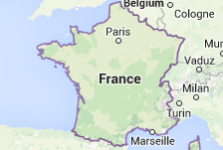Everything from over-hunting and a peasant uprising to deforestation and an alien invasion has been proposed to explain why the Mayan civilization collapsed, Smithsonian, notes. But one theory has been gaining ground in recent years: extreme drought. Now more evidence has surfaced to support the drought postulation—and the proof may just lie in Belize’s most famous underwater cave. Rice University professor Andre Droxler’s team analyzed sediment found in the “Great Blue Hole,” a 410-foot-deep sinkhole in the middle of Lighthouse Reef, LiveScience reports. Not only did the chemical composition of the silt indicate periods of sparse rainfall during the Mayan decline (likely between AD800 and AD1000): It also showed that a second huge drought probably occurred between AD1000 and AD1100—right around the time the Mayans’ relocation site of Chichen Itza is said to have fallen.
Over thousands of years, runoff from rivers and streams during periods of ample rainfall deposited layers of sediment in the Blue Hole’s lagoon, offering scientists a geological timeline to examine. “It’s like a big bucket,” Droxler tells LiveScience. “It’s a sediment trap.” Excessive rain also erodes volcanic rock, which contains titanium. Droxler’s team found that the sediment’s mineral composition—specifically, the low ratio of titanium to aluminum—in the lagoon indicated periods of low rainfall during the times when the Mayas, for the most part, disappeared. Scientists surmise that due to a climate glitch, monsoons may have skipped over the Yucatan Peninsula during these periods, leading to eventual catastrophe all around. “When you have major droughts, you start to get famines and unrest,” Droxler explains.






